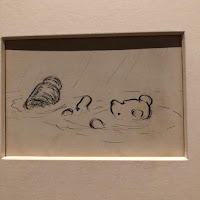Fourth Plinth : The Invisible Enemy Should not Exist

Lovely new sculpture on the Forth Plinth in Trafalgar Square by Michael Rakowitz. It is a recreation of the Lamassu, a winged bull and protective deity that stood at the entrance to Nergal Gate of Nineveh, near modern day Mosul, from c 700 B.C, until it was destroyed by ISIS in 2015. It is part of a larger project to recreate 7000 works looted from the Iraq Museum in 2003 or destroyed at archaeological sites across the country in the aftermath of the war. Rakowitz has decorated it with empty Iraqi date syrup cans to represent an industry destroyed by the war and to mirror the fact that the reliefs on the base of Nelson’s Column are made from canons salvaged from the wreck of a ship lost at the Battle of Trafalgar. I think this is one of the more successful works on the plinth. It fits it well and the colours mirror the colours of the square around it. It is also an important statement to shop a work of art destroyed by war outside our own National Gal...




















